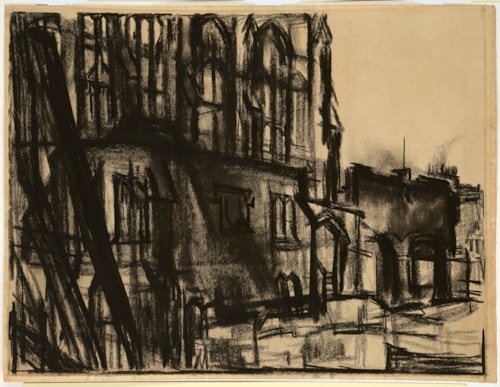
David BOMBERG
Birmingham 1890 - London 1957
Biography
The son of a Polish immigrant, David Bomberg was apprenticed to a lithographer as a youth, but was determined to establish himself as an artist. He took evening classes at the Westminster School with Walter Sickert and at the Central School of Arts and Crafts, and in 1911 was admitted into the Slade School of Art, aided - as were his fellow pupils Isaac Rosenberg and Mark Gertler - by a loan from the Jewish Education Aid Society. At the Slade he was a student of Henry Tonks and Fred Brown, alongside Paul Nash, William Roberts, Stanley Spencer, Edward Wadsworth and Christopher Wynne Nevinson. Like many of his fellow students, Bomberg was fascinated by his exposure, at such events as Roger Fry’s two Post-Impressionist exhibitions at the Grafton Gallery, to the work of Cézanne, Matisse and Picasso, as well as to such radical artistic movements on the Continent as Cubism and Futurism. A trip to Paris resulted in encounters with Picasso, Modigliani and Derain, and Bomberg was invited by Wyndham Lewis to exhibit with the Vorticist Group in London.
In 1914 the young artist, aged just twenty three, and a year out of the Slade, was given a large one-man exhibition at the Chenil Galleries in Chelsea, which generated much critical comment. After a period of military service in the First World War, first with the Royal Engineers and later as an infantryman on the Western Front, Bomberg produced a major painting of Sappers at Work for the Canadian War Memorials Fund in 1919. In the 1920s he began to travel to Spain and Palestine, and these trips resulted in a number of superb landscape paintings and drawings.
A period spent in Spain in the 1930s, where Bomberg lived in the rugged mountains of the remote and somewhat isolated province of Asturias, was immensely fruitful, but the outbreak of the Spanish Civil War forced him to return to London at the end of 1935. During the Second World War, a commission from the War Artists Advisory Committee led Bomberg to a bomb store in a disused mine near Burton-on-Trent, where he made numerous drawings and oil sketches of the site in 1942. (The bomb store was destroyed in 1944 in a massive explosion - the largest ever recorded in Britain - caused by the accidental detonation of a bomb and the chain reaction that followed.) Between 1945 and 1953 Bomberg worked as an art teacher at the Borough Polytechnic, where among his students was Frank Auerbach and Leon Kossoff. He was a gifted and much admired teacher, and several of his pupils formed the Borough Group, with Bomberg as its figurehead and leader.
Despite his early successes before the First World War, Bomberg struggled for recognition as an artist throughout his later career. He lacked a dealer who could champion and promote his work, and did not even figure in Herbert Read’s book Contemporary British Art, published in 1951. Indeed, the only significant survey exhibition of Bomberg’s work to be held after the First World War was a relatively modest show of thirty-seven works at the Heffer Gallery in Cambridge in 1954. In the same year he returned to Spain, hoping to set up an art school in the mountaintop city of Ronda in Andalusia. Although this never came to pass, many of Bomberg’s students visited him in Ronda and painted there. It was not until just after his death, when the Arts Council organized a retrospective exhibition of his work, that Bomberg achieved a measure of recognition. Only in the 1980s, however, with the publication of an important monograph on the artist by Richard Cork and a major exhibition of his work at the Tate Gallery, has Bomberg’s reputation been firmly established. He is today regarded, both as an artist and as a teacher, as a highly significant figure in 20th century British art.


